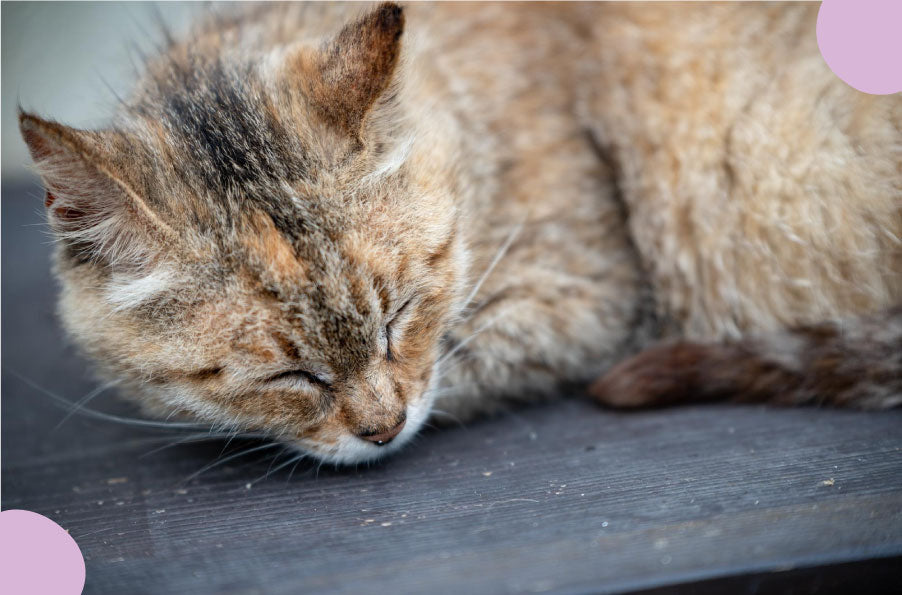Cat Scabies: Symptoms, Transmission, and Prevention Tips to Protect Your Home

Is your cat scratching furiously, seeming agitated and uncomfortable? It could be dealing with mange, a skin disease caused by microscopic mites. But don't worry—with the right information and appropriate treatment, this condition can be effectively managed. In this article, we'll delve deep into what mange is, how it manifests in your cat, and the best ways to treat and prevent it.
- What is cat mange
- Transmission and impact on health
- Diagnosis, treatment, and follow-up of cat mange
1. What is cat mange and how does it manifest?
Cat mange is a skin disease caused by parasitic mites that embed under your cat's skin, causing severe itching and skin lesions. There are several types of mange:
- Ear mange (otodectic mange): Caused by the mite Otodectes cynotis, this form primarily affects the ears. Symptoms include intense ear scratching, frequent head shaking, and an accumulation of dark earwax accompanied by an unpleasant odor.
- Notoedric mange: Due to the mite Notoedres cati, this mange often starts around the ears and face before spreading to the rest of the body. It causes severe itching, crusts, and can even be transmitted to humans.
- Sarcoptic mange: Less common in cats, it's caused by Sarcoptes scabiei and can also affect humans. Symptoms include intense itching, skin lesions, and hair loss.
Common signs of mange include excessive scratching, crusts, localized hair loss, and thickened skin (lichenification). If your cat shows these symptoms, it's important to act quickly to avoid more serious complications.
2. Transmission, prevention, and impact on your cat's health
Mange is a highly contagious disease. Your cat can contract it through direct contact with another infested animal or by touching contaminated objects like beds, toys, or brushes. Some forms of mange, such as notoedric mange and ear mange, are specific to cats and do not transmit to humans. However, sarcoptic mange is an exception: it can be transmitted not only to other pets but also to humans. This transmission, though rare, can cause itching and skin lesions in humans similar to those observed in animals.
Prevention is essential to protect your cat, other animals in your home, and even yourself. Here are some preventive measures to adopt:
- Regular antiparasitic treatment: Apply an appropriate antiparasitic treatment every month that protects against mites, fleas, ticks, and other parasites. This helps prevent the initial infestation and reduces the risk of transmission to humans.
- Strict hygiene: Regularly clean your cat's environment, especially their sleeping areas, toys, and brushes. Good environmental maintenance can significantly reduce the risk of cross-contamination between animals and between animals and humans.
- Control of interactions: Limit contact with untreated or potentially infected animals. If you adopt a new pet, quarantine it before allowing it to interact with other household members, including humans, to prevent any spread.
A healthy skin and coat are natural barriers against parasitic infections. Nutrition plays a crucial role in this. By offering your cat foods rich in essential nutrients, you can strengthen their skin barrier and reduce the risk of infestation. Our Skin & Coat 100% Salmon Treats are ideal for this, as they contain omega-3 and 6 that nourish your cat's skin and coat.
Discover our Skin & Coat Treats for a cat radiating health! 🤩

3. Diagnosis, treatment, and follow-up of cat mange
If you suspect your cat has mange, it's essential to consult a veterinarian for an accurate diagnosis. The vet can perform a thorough clinical examination, including a skin scraping or earwax sample to identify the presence of mites under a microscope.
Treatment varies depending on the type and severity of the infestation. Generally, it includes:
- Antiparasitic pipettes: Applied directly to the skin, they eliminate mites and prevent new infestations.
- Specific shampoos and lotions: Used to treat skin lesions and soothe itching.
- Oral medications: In more severe cases, antiparasitic tablets may be prescribed for systemic treatment.
It's important to treat all animals in the household to prevent the spread of infestation and to thoroughly disinfect the environment to eliminate any mites present. Regular follow-up with the veterinarian is also recommended to ensure the treatment is effective and that the mange is completely eradicated.
Finally, even after treatment, it's crucial to maintain good hygiene for your cat. Provide regular care, a balanced diet, and lots of love to keep them in optimal health. And don't forget, our Skin & Coat 100% Salmon Treats are not only delicious but also help maintain healthy skin, perfect for preventing potential skin infections. Try them today!
FAQ
Cat mange is rarely contagious to humans, except in the case of sarcoptic mange. If you have any doubts, consult a doctor.
Symptoms include intense itching, crusts, hair loss, and thickened skin. A veterinarian can confirm the diagnosis.
It's essential to follow a treatment prescribed by a veterinarian, which may include pipettes, shampoos, or tablets. It's also important to treat all animals in the household.




